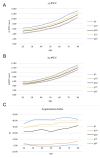A Population-Based Scoring System to Assess the Impact of Individual Risk Factors on Vascular Health
- PMID: 37728581
- PMCID: PMC11081151
- DOI: 10.14336/AD.2023.0823
A Population-Based Scoring System to Assess the Impact of Individual Risk Factors on Vascular Health
Abstract
Arterial stiffness is an indicator of vascular health, influenced by both pathological conditions and physiological determinants, noticeably age. Augmentation index (AI) and pulse wave velocity (PWV) are used among others to assess arterial stiffness. Several risk factors may contribute to pathologically increase arterial stiffness and produce early vascular aging. Our study aims to assess the impact of individual risk factors on vascular health, evaluating the distribution of PWV and AI values in a cohort of adult people without modifiable cardiovascular risk factors while analyzing their role in accelerating vascular ageing. We performed a secondary analysis of a Swiss population-based research project, which took place in 2017 and 2018. Of the 1202 participants originally enrolled, 1097 were included in the final sample. The population was divided into without (n=388) and with risk factors (n=709), based on the presence of the following: smoking, diabetes, previous cardiovascular disease (CVD), chronic kidney disease stage 3 or more, LDL cholesterol ≥ 4.11 or treatment with hypolipidemic drugs, hypertension or treatment with antihypertensive drugs, and metabolic syndrome. Tonometric and oscillometric devices were employed to assess PWV, and the 75th percentiles of PWV and AI in the population without risk factors were calculated to identify cut-offs for the logistic regression analysis. We developed nomograms by assigning a numerical score to each independent prognostic factor; the total score estimating the probability of PWVs and AIs being over the defined cut-offs. Patients with hypertension, diabetes, and obesity showed higher PWV values (p < 0.001). In the univariate logistic regression, factors predictive for higher PWV values were diabetes, CVDs, hypercholesterolemia, and hypertension, while CVDs, antihyperlipidemic treatment, hypertension, and increased BMI were predictive in the multivariate logistic regression. Smoking did not significantly influence arterial stiffness parameters. The present study provides reference values for PWV and AI in subjects without modifiable cardiovascular risk factors and, through nomograms, a risk score stratification to assess the impact of individual risk factors on vascular health.
Conflict of interest statement
The authors declare no conflict of interest.
Figures



Similar articles
-
Comparing oscillometric and tonometric methods to assess pulse wave velocity: a population-based study.Ann Med. 2021 Dec;53(1):1-16. doi: 10.1080/07853890.2020.1794538. Epub 2020 Aug 13. Ann Med. 2021. PMID: 32729734 Free PMC article.
-
Impact of Cardiovascular Factors on Pulse Wave Velocity and T otal Vascular Resistance in Different Age Group Patients with Cardiovascular Disorders.Curr Aging Sci. 2019;11(4):261-268. doi: 10.2174/1874609812666190226151500. Curr Aging Sci. 2019. PMID: 30813882 Free PMC article.
-
Parameters of pulse wave velocity: determinants and reference values assessed in the population-based study LIFE-Adult.Clin Res Cardiol. 2018 Nov;107(11):1050-1061. doi: 10.1007/s00392-018-1278-3. Epub 2018 May 15. Clin Res Cardiol. 2018. PMID: 29766282 Free PMC article.
-
Advanced vascular aging and outcomes after acute ischemic stroke: a systematic review and meta-analysis.J Hum Hypertens. 2024 Oct;38(10):676-686. doi: 10.1038/s41371-024-00961-y. Epub 2024 Sep 24. J Hum Hypertens. 2024. PMID: 39317753
-
Early vascular aging in acute ischemic stroke: A systematic review and meta-analysis.J Stroke Cerebrovasc Dis. 2024 Aug;33(8):107800. doi: 10.1016/j.jstrokecerebrovasdis.2024.107800. Epub 2024 May 24. J Stroke Cerebrovasc Dis. 2024. PMID: 38797457
Cited by
-
Closer look at the cardiovascular and metabolic predictors of postpartum depression.World J Psychiatry. 2025 Jun 19;15(6):106283. doi: 10.5498/wjp.v15.i6.106283. eCollection 2025 Jun 19. World J Psychiatry. 2025. PMID: 40574759 Free PMC article.
-
Advancing Neurological Health: Insights into Aging, Immunity, and Vascular Dynamics.Aging Dis. 2024 May 7;15(3):939-944. doi: 10.14336/AD.2024.0423. Aging Dis. 2024. PMID: 38722789 Free PMC article.
References
-
- Mattace-Raso FU, van der Cammen TJ, Hofman A, van Popele NM, Bos ML, Schalekamp MA, et al.. (2006). Arterial stiffness and risk of coronary heart disease and stroke: the Rotterdam Study. Circulation, 113:657-663. - PubMed
-
- Ohkuma T, Ninomiya T, Tomiyama H, Kario K, Hoshide S, Kita Y, et al.. (2017). Brachial-Ankle Pulse Wave Velocity and the Risk Prediction of Cardiovascular Disease: An Individual Participant Data Meta-Analysis. Hypertension, 69:1045-1052. - PubMed
-
- Scuteri A, Benetos A, Sierra C, Coca A, Chicherio C, Frisoni GB, et al.. (2021). Routine assessment of cognitive function in older patients with hypertension seen by primary care physicians: why and how-a decision-making support from the working group on 'hypertension and the brain' of the European Society of Hypertension and from the European Geriatric Medicine Society. J Hypertens, 39:90-100. - PubMed
Publication types
MeSH terms
LinkOut - more resources
Full Text Sources
